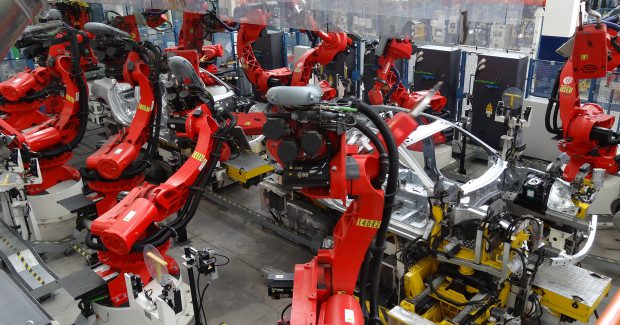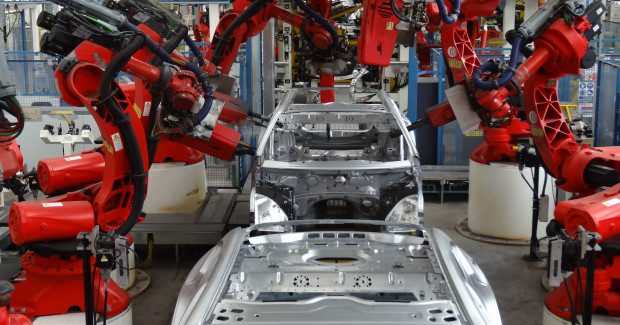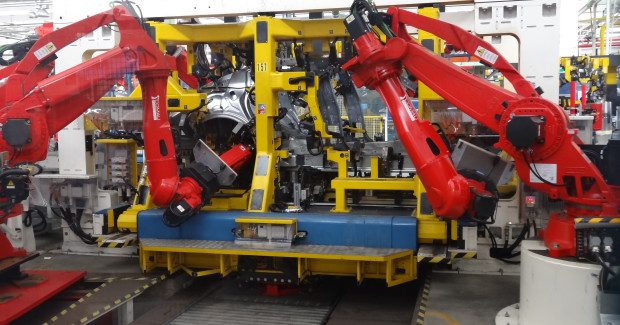Building Objects of Desire
With articulated robots and advanced software applications that can simulate every stage of production, Maserati leverages innovative robotic solutions from Comau to build the Quattroporte and Ghibli, two of the most prestigious models of luxury, sporty lines and aggressive engines.
Posted: March 21, 2015
To summarize, the entire process involves the assembly of parts and subgroups through the insertion of 4,785 welds for each model. Of these, 1,083 welds are performed in advance and 3,702 welds are made during the sheet metal working phase (1,025 welds are done by hand and 2,677 welds are performed automatically). On the line, 190 rivets and 243 arc-welded studs are applied for each model. Finally, almost 79 m of semi-structural adhesive are spread, 66 m of which by means of the robot and 13 m manually.
After the sheet metal working phase, each body is sent to the painting and final assembly sections. “Before being put on the market,” adds Filippini, “every vehicle is carefully controlled and verified using simulation based on specific test benchmarks, and with a complete road test that covers a distance of 40 km.”
A SUCCESSFUL COMBINATION
Given that the automated metalworking line at the Maserati plant in Grugliasco is almost exclusively based on articulated robots provided by Comau, Filippini wants to avoid any misunderstanding. “Comau and Maserati are both part of Fiat Chrysler Automobiles,” he clarifies. “Despite belonging to the same group, Maserati is completely free to search for and select new partners according to its needs, even outside the group. This means that the strong presence of Comau in our plant is entirely due to the merit of their work in the field.”
Comau is not merely a supplier of equipment for the automobile manufacturer, but a solid partner with whom it can work to discuss and develop projects and activities. Through their mutual collaboration, the two companies aim to define new customized production standards according to market needs. In this regard, Novara underscores the value of the relationship. “We work very closely with the Body Welding and Robotics departments and, as a result, Comau provides all the equipment and robots necessary for our production lines,” he says. “In some of our other plants, they are also the Line Builder, which means that they integrate technologies and develop the lines themselves, even if they didn’t build the lines here in Grugliasco. Overall, this collaboration is very important for us.”
In the Grugliasco plant, the 82 Comau robots include various types, such as articulated and multi-axis, that are specifically designed to ensure a reduced footprint, a larger working area, and high-precision movement and positioning while covering all payload categories and applications. More specifically, the robots are available in different ‘wrist’ versions, including the ‘standard wrist’ version with external dressing and the innovative ‘hollow wrist’ version where the welding equipment is housed inside the forearm. Hollow wrist robots feature a reduced footprint because the various cables for the welding guns, air flow, and other the cables all run inside the robot arm (i.e. the ‘hollow wrist’) to reach the head.
“Generally speaking,” continues Novara, “these robots are technologically advanced, high-performing, and easy to maintain. They are also reliable, flexible and specifically tailored to suit all our applications. The robots can be employed in low- and medium frequency lines, such as in the Grugliasco plant where a body is produced in slightly more than five minutes, as easily as in high-frequency lines, such as the plants in Melfi, Cassino and Pernambuco in Brazil, where the cycle time of each body is around 50 seconds.”
It’s interesting to note, perhaps surprisingly, that the lines with high frequency and long cycles are operations in which the robots work under the most stressful conditions, in particular the dressing operation of cable bundles, accessories, etc., where they must perform sequences of more complex, articulated movements.
NEXT STEP NETWORKING
The two years between the moment in which the plant of Grugliasco was planned and the moment in January, 2013, when the first Maserati was produced, were characterized by hard work and continuous improvement. Comau and other partners were heavily involved in the project, especially in the last months of its implementation. “Comau has always been ready to help us and listen to our observations and needs, especially when studying and developing the characteristics of the network that we call standard cars,” notes Filippini. “This network allows us to monitor the process of the line at any moment and at any point, as well as exchange and analyze process data and check the state of the safety systems.”
One of the most satisfying elements of the partnership was the development of specific software applications that provide accurate, detailed offline simulation of each stage in the production line. As Novara explains, thanks to the applications developed in collaboration with Comau, Maserati was able to verify the entire sheet metal working process in a virtual format sequence before it was actually implemented. “This enabled us to anticipate and correct mistakes and significantly reduce operating times and costs,” he adds. “It wasn’t a simple operation, as it’s really difficult to predict the movement of numerous robots and their related dressings while they perform so many diverse operations at the same time. The risk of collisions is extremely high.”
“The plant has been operating for just over two years and we’re really proud of the results we have achieved,” states Filippini. “During this time, there has been a continuous technological exchange with Comau. Every plant can suggest new improvements during the work phase in order to solve specific problems, enhance the operational efficiency of the production processes or to further simplify the maintenance stages, which are already very simple. This ongoing collaboration is the foundation of future production. An example of this is coming soon when the new low-emission Euro 6 engines become mandatory for all vehicles. Thanks to our robots, we are ready for it.”
The work in this network doesn’t end here. Since new welding technologies are devised every day, new software applications are being developed in order to expand the possibilities of the line. It’s part of Comau’s belief in the value of research and its commitment to the development of increasingly advanced, up-to-date solutions for Maserati as well as automotive companies, all over the world, inside and outside the FCA Group.
Comau SpA, Via Rivalta, 30, 10095 Grugliasco TO, Italy, +39 011 004 9111, www.comau.com.
Comau LLC, 21000 Telegraph Road, Southfield, MI 48033, 248-353-8888, www.comau.com/eng.

















